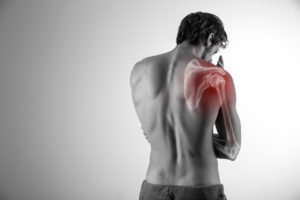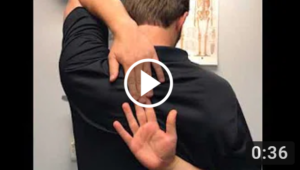Understanding Shoulder Pain
 Shoulder pain can manifest in a number of ways, and can be caused by a number of underlying issues. When we try to determine what is causing shoulder pain, we must be able to understand the shoulder and how complex it is. Having knowledge of how the shoulder works will go a long way toward understanding shoulder pain and how to eliminate it!
Shoulder pain can manifest in a number of ways, and can be caused by a number of underlying issues. When we try to determine what is causing shoulder pain, we must be able to understand the shoulder and how complex it is. Having knowledge of how the shoulder works will go a long way toward understanding shoulder pain and how to eliminate it!
Anatomical origins
Similar to the lower extremity, the upper extremity has 3 main articulations or joints: the wrist, the elbow and the shoulder. Grouped into the shoulder joint is also the articulation between the shoulder blade (scapula) and the humerus bone, which completes the shoulder complex. When we discuss the shoulder, however, we aren’t just limited to talking about the extremity. The acromioclavicular joint also contributes to the shoulder’s overall biomechanical integrity. Additionally, the cervical spine is another key player in the function of the shoulder joint/shoulder capsule due to the number of muscles the attach the two areas. We must look at all of these regions to get a grasp on understanding shoulder pain; each joint or set of joints have different roles and functions during movement. The lower cervical spine, scapula and elbow regions are considered “stable” while the shoulder and wrist joints are considered “mobile”.
Stability vs. Instability
When an area of the body becomes less stable (i.e. the cervical spine or elbow), more stress is placed on the surrounding mobile joints to make up for and absorb additional stress, thus causing altered mobility. An increase in mobility can be caused by ligament sprains, while a decrease in mobility is normally caused by the surrounding muscle’s reaction harmful stress. When understanding shoulder pain, you need to comprehend that mobile joints like the shoulder are relied upon to perform movements and carry a bulk of the stress in that region. The addition of unwanted stress predisposes the shoulder to injury by resulting in hyper (too much) or hypo (not enough) mobility.
Treatment Options
Treatment of shoulder complaints at Elite Sports and Spine Chiropractic are based off a thorough evaluation, leading to a problem-focused diagnosis. Generally, our chiropractors perform soft tissue therapies to tight muscles of the shoulder, mobilize the shoulder joint itself and give the patient stretching and strengthening exercises to perform in our gym. One simple at-home check for tight shoulders is this shoulder ROM test.
This test determines if you have shoulder tightness, predisposing you to injury. If this test demonstrates dysfunction when you perform it, we suggest getting your problem evaluated by one of our sports chiropractors.

